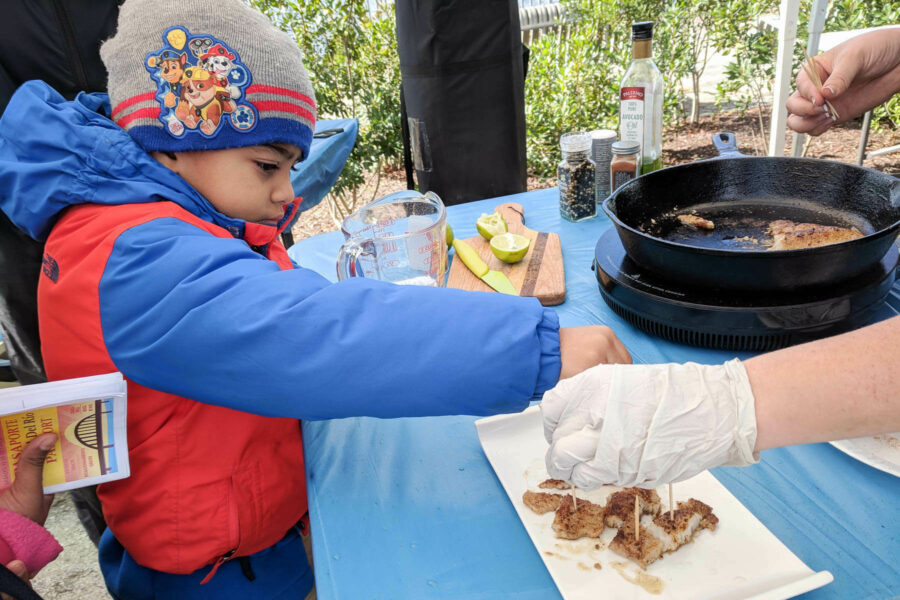Dishing on fish consumption
2018 Festival del Rio Anacostia provides a taste of safe prep for local fish

Along the outer edges of Washington, D.C., a forgotten river runs through a paved and crowded metropolitan suburb. Known as the Anacostia, this urban river has struggled to receive more than an F health grade for decades. With the help of the Anacostia Watershed Society, other organizations and individual residents, the river is slowly improving. One of the main strategies to improve the Anacostia is to get people acquainted with it—at times, that even comes with food.
Festival del Rio Anacostia is a free bilingual event that marries cultural celebration and environmental education at Bladensburg Waterfront Park each October. On the water, a naturalist guide leads boat tours every half hour and residents try their hand at free fishing off the pier. On land, cheerful music pipes over visitors that wind their way between exhibits with water safety tips, art activities, live birds and tanks swimming with local fish.
At the Chesapeake Bay Program table, I am doing a filleting and cooking demonstration of safe fish preparation with catfish. A small boy in a bright red coat is fixated on the sample tasting plate. “Hang on, little guy,” I say with a laugh. “I have to put the lime juice on it first, remember?”
Over the last several years, the Chesapeake Bay Program has been working on an effort to educate the public about safety in fish consumption. The old saying goes “you are what you eat,” and fish that live in polluted waters tend to ingest pollutants. Fish consumption advisories are intended to let people know what fish species are safe to eat and in what quantities.
Catch and release fishing is promoted on the Anacostia while it remains polluted, and the fish being prepared at our table came from Ivy City Smokehouse in Washington, D.C., rather than its waters. However, many D.C. residents still rely on the river for their dinner, and it is important to know how to reduce exposure to toxic contaminants in fish.
Polluted waterways include several kinds of contaminants that react in different ways. PCB, a contaminant common in urban areas, concentrate in the fat and skin of a fish. By filleting a fish to remove the skin and throwing away used cooking oil, you can make a fish much safer to consume. Festival-goers got to test that out in samples while we talked about safe practices, and everyone took home a recipe card with safety information on the back.
The goal for the Anacostia is to be fishable and swimmable by 2025, and festivalgoers chat about ways to make that happen while snacking on samples. With people experiencing the river in action, learning ways to help it and tasting that possibility at fun events like the Festival del Rio Anacostia, the health of this river and the enjoyment of the people who live on it will only improve.

Comments
The Festival is held every year during Hispanic Heritage Month, which runs September 15th to October 15th. This year the festival was held Saturday, October 13.
Yes, you can fish during the event! It is also a great opportunity to introduce people to fishing for the first time. Anacostia Riverkeepers runs free, guided fishing during the event as long as festivalgoers have a fishing license or are exempt from licensing requirements (under the age of 16). Fishing poles and bait are provided, with an experienced individual on hand from Anacostia Riverkeeper to assist and answer questions. Bladensburg Waterfront Park is on the Anacostia river, so catch and release is strongly encouraged.
Fish advisories are specific to communities and rivers, and change along with environmental conditions. For those that want to keep fish caught in the area, the current fish consumption advisories are posted on the fishing pier at Bladensburg Park. As of October 13, the advisories were as follows: an orange advisory for brown bullheads, sunfish and largemouth bass; a red (more restricted and cautious) advisory for American eel; a red recommendation to completely avoid channel catfish and large brown bullheads' and a "DO NOT EAT" advisory on common carp.
You can learn more about fish consumption advisories and how to find them in your area here (toward the bottom of the page): https://www.chesapeakebay.net/issues/chemical_contaminants.
Nicely done piece! When was Festival Del Rio Anacostia held? What kind of fish are typically caught there? Were fish caught during the event? Thanks.
Thank you!
Your comment has been received. Before it can be published, the comment will be reviewed by our team to ensure it adheres with our rules of engagement.
Back to recent stories